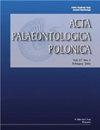Terrestrial-aquatic wood-inhabiting ascomycete Potamomyces from the Miocene of Poland
IF 1.8
3区 地球科学
Q2 PALEONTOLOGY
引用次数: 2
Abstract
Terrestrial-aquatic wood-inhabiting ascomycete Potamomyces from the Miocene of Poland. Acta Palaeontologica Polonica 67 (X): xxx–xxx. We report fungal ascospores of Potamomyces affinities from four Miocene localities in Poland. The spores are similar to the ones known from extinct species of Potamomyces invaginatus , Potamomyces batii , and Potamomyces pontidiensis , as well as to living Potamomyces armatisporus . Living representatives of Potamomyces are saprophytic, and usually found on decaying wood. They are mainly found in a freshwater or brackish environment, and sometimes also on terres -trial, moist to damp substrates. Therefore, the species of Potamomyces can be classified as a facultative-aquatic or terres-trial-aquatic fungus. Both living and extinct species of Potamomyces prefer a tropical to subtropical, and usually humid climate as their past and recent distribution is mostly confined to the intertropical zone. Fossil record of the Potamomyces ranges from the Lower Miocene to the Holocene, covering all continents with the exception of the Antarctica. Miocene findings of Potamomyces from Poland represent the first known fossil record of this genus from Europe and confirm the warm temperate to subtropical and humid climate during Middle to Late Miocene of present Poland previously inferred from palaeobotanical investigations.波兰中新世陆水栖木栖子囊菌
波兰中新世陆水栖木栖子囊菌。古生物学报67 (X): xxx-xxx。我们报告了波兰四个中新世地区的Potamomyces亲缘真菌子囊孢子。这些孢子与已知的已灭绝的凹形Potamomyces,巴蒂Potamomyces batii和庞蒂迪Potamomyces pontidiensis以及现存的马氏Potamomyces armatisporus的孢子相似。马铃薯菌的活的代表是腐生的,通常在腐烂的木头上发现。它们主要生长在淡水或半咸淡水环境中,有时也生长在陆地、潮湿的基质上。因此,Potamomyces的种类可以分为兼性水生真菌和地试水生真菌。由于其过去和最近的分布主要局限于热带地区,因此无论是现存的还是已灭绝的马铃薯菌种都喜欢热带而不是亚热带,通常是潮湿的气候。Potamomyces的化石记录范围从下中新世到全新世,覆盖了除南极洲以外的所有大陆。来自波兰的中新世Potamomyces的发现代表了该属在欧洲的第一个已知化石记录,并证实了以前从古植物学调查中推断的现在波兰中新世中期至晚期的暖温带至亚热带湿润气候。
本文章由计算机程序翻译,如有差异,请以英文原文为准。
求助全文
约1分钟内获得全文
求助全文
来源期刊

Acta Palaeontologica Polonica
地学-古生物学
CiteScore
2.80
自引率
5.60%
发文量
36
审稿时长
12.5 months
期刊介绍:
Acta Palaeontologica Polonica is an international quarterly journal publishing papers of general interest from all areas of paleontology. Since its founding by Roman Kozłowski in 1956, various currents of modern paleontology have been represented in the contents of the journal, especially those rooted in biologically oriented paleontology, an area he helped establish.
In-depth studies of all kinds of fossils, of the mode of life of ancient organisms and structure of their skeletons are welcome, as those offering stratigraphically ordered evidence of evolution. Work on vertebrates and applications of fossil evidence to developmental studies, both ontogeny and astogeny of clonal organisms, have a long tradition in our journal. Evolution of the biosphere and its ecosystems, as inferred from geochemical evidence, has also been the focus of studies published in the journal.
 求助内容:
求助内容: 应助结果提醒方式:
应助结果提醒方式:


